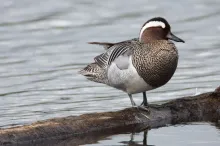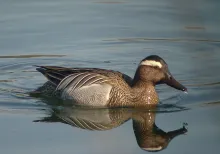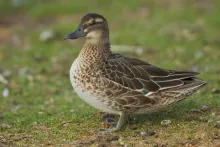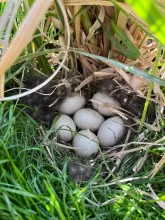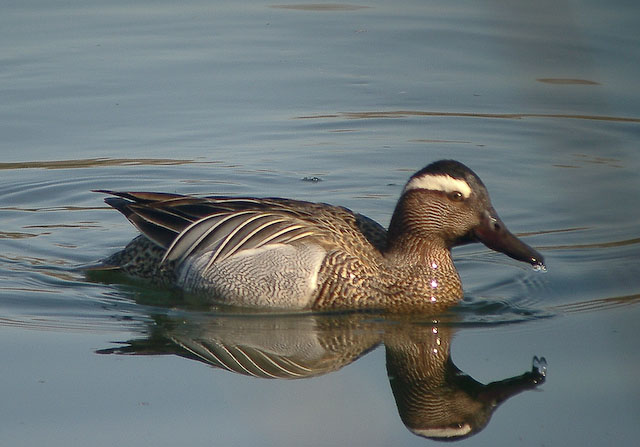
Garganey (Anas querquedula)
Species name
- Dutch name:
- Zomertaling
- English name:
- Garganey
- German name:
- Knäkente
- French name:
- Sarcelle d'été
- Scientific name:
- Anas querquedula
Scientific classification
- Order:
- Anseriformes
- Family:
- Anatidae
- Onderfamilie:
- Anatinae
- Genus:
- Anas
Description
- Description:
Male:
Has Blackish crown and upper nape above broad white stripe from in front of eye, tapering down hindneck; black patch on chin. Cheeks, throat and sides of neck reddish brown, finely streaked whitish. Breast browner with fine, black crescentic markings, sharply demarcated from grayish baby blue-vermiculated flanks, darker towards rear; belly white; ventral region and undertail-coverts whitish with dark brown bars and spots. Mantle brown with black markings; elongated scapulars blackish, strongly striped baby bluish fringed with white, and drooping over closed wing; back and rump, upper tail coverts and tail blackish. Primaries Dark grey, but forewing pale blue-grey, with broad with stripe in front of iridescent dark Speculam, edged very narrowly behind with white; underwing white centered, with dark leading edge and grey flight feathers. Bill, legs, and feet dark grey.
Call a distinctive mechanical rattleFemale:
They are slightly paler overall and have larger streaks on their plumage and more distinct eye stripes. They also have a second less distinct stripe beneath their eyes, and a distinct pale patch by their beak. They have brown irises.Juvenile:
Similar to female. First fall males molt into their breeding plumage first winter
Standard Measurements
- Body Length (cm):
- The male (drake) of the Garganey measures approximately 31-36 centimeters. The female measures approximately 31-36 centimeters.
- Body Weight (grams):
- The male will weight about 370-395 gram. The female will weight about 370-395 gram.
The weight is notoriously variable and can only be used as indication!
- Note:
Dabbling Ducks are generally hardy, easy to maintain and easy to breed. Shelter may be required by some of the smaller species in winter. They should be provided with cover (including marginal pond cover) and loafing areas as well as water. A pen which is 50% water is suggested. The water may be shallow (i.e. no more than two feet deep is required), and muddy areas for dabbling in are also appreciated. These ducks are generally good in mixed collections, although the smaller and quieter species may be bullied. Territorial disputes between ducks of the same species may be avoided by keeping only one pair of each species in an enclosure, unless the area is very large. For a single pair of ducks a pen are of 50 to 100 square metres, depending on the size of duck, should be provided.
A diet based on wheat and pellets is suggested, with maintenance pellets changed to breeders pellets for the breeding season. Bread and greenfood are also appreciated. Grit should always be available, with soluble grit (e.g. oystershell grit) as a calcium source when breeding.
Most species are ground nesters and both close ground cover and ground level nest boxes should be provided. Hand-rearing is generally preferred, as these ducks are generally poor parents in captive conditions, particularly in enclosures shared with other waterfowl. These ducks are prone to hybridization, particularly with closely related species, which should be kept apart from one another.
Garganey are hardy, but shelters and/or good ground cover should be provided for protection in prolonged /severe frost. These ducks are easy to manage, and suitable for mixed collections but are quiet and may be bullied. Feed as other Dabbling Ducks: wheat, pellets, greenfood, grass.
These ducks are shy and somewhat difficult to breed. Dense cover and seclusion, without competition, should be provided. Nest in areas of grass or low-growing plants at a distance from water, lay April to May, with replacement clutches sometimes laid as late as June if the eggs are removed. They are very sensitive to disturbance while sitting and broody or artificial incubation is suggested. Ducklings are not difficult to rear; they start feeding easily, but need care and protection when young. Starter crumbs with greenfood such as duckweed may be fed.
This species may hybridise with Anas species, Aythya species; they should be kept separated from the closely-related Blue-winged teal (Anas discors) and Cinnamon teal (Anas cyanoptera). Hybrids also reported with Wood duck (Aix sponsa).
- Breeding:
- The female Garganey usually lays from 7-9 cream to pale coffee eggs and incubates them for 21-25 days.
- Artificial incubating:
The ideal relative humidity for incubating most waterfowl eggs is 55% (ground nesters) and 40% (cavity nesters). The temperature is usually 37.4°C. Set ventilation as recommended by the incubator manufacturer. Eggs must be turned, either automatically or by hand, a minimum of 4 times a day. As the duckling develops there is a loss of water from the egg and the air sac gets bigger. In normal development of an egg with a 21-25 days incubation, the air sac occupies about a third of it three days earlier. Cleanliness is vital and ideally eggs should be moved to a separate hatcher at this point, where the humidity should be increased to 65% and even higher once they have pipped internally.
- Bird banding:
- Recommended closed leg band ring size for the Garganey is 7 mm.The leg band ring can only be applied on a young small dabbling duck at around 10 days old.
- It doesn't matter what leg that you band, but it's good to have a consistent system. Suggested: Left leg = Female, Right leg = Male
- Maintenance food:
-


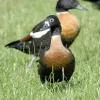


Floating full food for all sea ducks, green ducks, eider ducks and geese, especially in the moulting and breeding phase ideally suited. Packed with wholesome raw materials, natural vitamins and trace elements, this performance food with a protein content of 30% forms the basis for lifelong vitality.


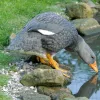
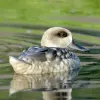
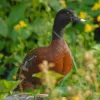


Floatable special complete food for sea birds with the highest nutritional requirements. Each chunk contains the complete nutrient spectrum. The high protein content of 35% ensures a healthy and species-appropriate diet. Spiral algae give a more magnificent coloration of plumage and sea salt promotes the salt gland.
- Regulation:
- Vrijstelling CITES, bijlage X



